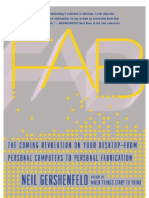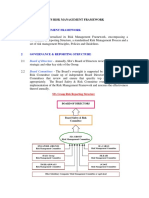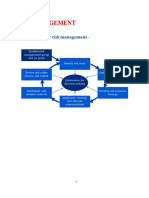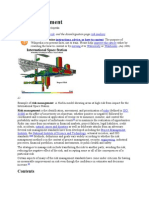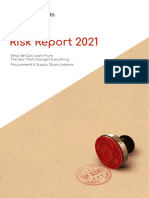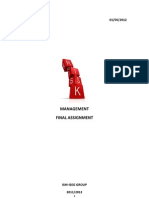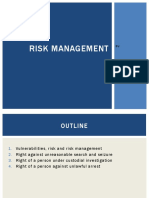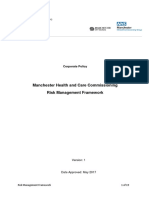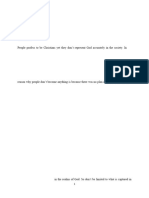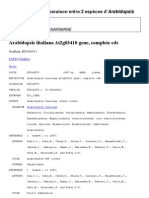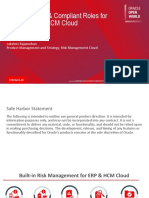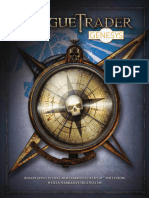0 ratings0% found this document useful (0 votes)
295 viewsRisk Management: 12.1 Business Risks 12.2 Insure Against Risks 12.3 Other Risks
Risk Management: 12.1 Business Risks 12.2 Insure Against Risks 12.3 Other Risks
Uploaded by
gel.silvestre23Risk Management is a topic in Entrepreneurship here in the Philippines.
Copyright:
© All Rights Reserved
Available Formats
Download as PPT, PDF, TXT or read online from Scribd
Risk Management: 12.1 Business Risks 12.2 Insure Against Risks 12.3 Other Risks
Risk Management: 12.1 Business Risks 12.2 Insure Against Risks 12.3 Other Risks
Uploaded by
gel.silvestre230 ratings0% found this document useful (0 votes)
295 views53 pagesRisk Management is a topic in Entrepreneurship here in the Philippines.
Original Title
Risk Management
Copyright
© © All Rights Reserved
Available Formats
PPT, PDF, TXT or read online from Scribd
Share this document
Did you find this document useful?
Is this content inappropriate?
Risk Management is a topic in Entrepreneurship here in the Philippines.
Copyright:
© All Rights Reserved
Available Formats
Download as PPT, PDF, TXT or read online from Scribd
Download as ppt, pdf, or txt
0 ratings0% found this document useful (0 votes)
295 views53 pagesRisk Management: 12.1 Business Risks 12.2 Insure Against Risks 12.3 Other Risks
Risk Management: 12.1 Business Risks 12.2 Insure Against Risks 12.3 Other Risks
Uploaded by
gel.silvestre23Risk Management is a topic in Entrepreneurship here in the Philippines.
Copyright:
© All Rights Reserved
Available Formats
Download as PPT, PDF, TXT or read online from Scribd
Download as ppt, pdf, or txt
You are on page 1of 53
At a glance
Powered by AI
Some of the key takeaways are that businesses need to identify, assess and manage various risks like human risks caused by individuals, natural risks from acts of nature, and economic risks from changes in business conditions.
Businesses may face human risks caused by the actions of individuals like theft, natural risks caused by acts of nature like fires or floods, and economic risks that occur because of changes in business conditions in the market.
Businesses need to consider human risks from theft or fraud, natural risks from events like fires or storms, and economic risks from changes in demand, costs, or other external factors in the business environment.
Chapter 12
Risk Management
12.1 Business Risks
12.2 Insure Against Risks
12.3 Other Risks
Entrepreneurship: Ideas in Action 5e
© 2011 Cengage Learning. All rights reserved. May not be scanned, copied or duplicated, or posted to a publicly accessible website, in whole or in part.
Lesson 12.1
Business Risks
Goals
List and explain steps involved in
preparing to face risks.
Discuss types of theft and security
precautions to take to protect your
business.
Chapter 12 Entrepreneurship: Ideas in Action 5e
Slide 2 © 2011 Cengage Learning. All rights reserved. May not be scanned, copied or duplicated, or posted to a publicly accessible website, in whole or in part.
Vocabulary
risk
risk management
risk assessment
shoplifting
bounced check
Chapter 12 Entrepreneurship: Ideas in Action 5e
Slide 3 © 2011 Cengage Learning. All rights reserved. May not be scanned, copied or duplicated, or posted to a publicly accessible website, in whole or in part.
Dealing with Business Risks
risk
the possibility of some type of loss
risk management
taking action to prevent or reduce the
possibility of loss to your business
Chapter 12 Entrepreneurship: Ideas in Action 5e
Slide 4 © 2011 Cengage Learning. All rights reserved. May not be scanned, copied or duplicated, or posted to a publicly accessible website, in whole or in part.
Identifying Risks
human risks
caused by the actions of individuals
natural risks
caused by acts of nature
economic risks
occur because of changes in business
conditions
Chapter 12 Entrepreneurship: Ideas in Action 5e
Slide 5 © 2011 Cengage Learning. All rights reserved. May not be scanned, copied or duplicated, or posted to a publicly accessible website, in whole or in part.
Preparing to Face Risks
When dealing with risk, choices you
have include
avoid the risk
assume the risk
transfer the risk
Chapter 12 Entrepreneurship: Ideas in Action 5e
Slide 6 © 2011 Cengage Learning. All rights reserved. May not be scanned, copied or duplicated, or posted to a publicly accessible website, in whole or in part.
Determine What Can Go Wrong
risk assessment
looking at all aspects of your business and
determining the risks you face
Develop a Plan
chain of command information
the names of individuals who assess risk
Chapter 12 Entrepreneurship: Ideas in Action 5e
Slide 7 © 2011 Cengage Learning. All rights reserved. May not be scanned, copied or duplicated, or posted to a publicly accessible website, in whole or in part.
preferred method for reporting
emergencies
specific instructions for how to shut down
equipment prior to evacuation
facility evacuation procedures
specific training for emergency response
personnel
Develop a recovery plan.
Chapter 12 Entrepreneurship: Ideas in Action 5e
Slide 8 © 2011 Cengage Learning. All rights reserved. May not be scanned, copied or duplicated, or posted to a publicly accessible website, in whole or in part.
Communicate Your Plan
communicate plans to personnel
delegate responsibilities
Chapter 12 Entrepreneurship: Ideas in Action 5e
Slide 9 © 2011 Cengage Learning. All rights reserved. May not be scanned, copied or duplicated, or posted to a publicly accessible website, in whole or in part.
What should you do to prepare for
business risks?
Chapter 1 Entrepreneurship: Ideas in Action 5e
Slide 10 © 2011 Cengage Learning. All rights reserved. May not be scanned, copied or duplicated, or posted to a publicly accessible website, in whole or in part.
Types of Theft
shoplifting
the act of knowingly taking items from a
business without paying
Consumers shoplift millions of dollars in
merchandise annually.
Chapter 12 Entrepreneurship: Ideas in Action 5e
Slide 11 © 2011 Cengage Learning. All rights reserved. May not be scanned, copied or duplicated, or posted to a publicly accessible website, in whole or in part.
Employee Theft
To deter theft, take the following
precautions:
Do not hire dishonest employees.
Install surveillance systems.
Establish a tough company policy regarding
theft.
Be on the lookout.
Chapter 12 Entrepreneurship: Ideas in Action 5e
Slide 12 © 2011 Cengage Learning. All rights reserved. May not be scanned, copied or duplicated, or posted to a publicly accessible website, in whole or in part.
Robbery
Most businesses are vulnerable to
robberies.
dead-bolt locks
burglar alarms
surveillance cameras
Credit Card Fraud
electronic credit authorizer
Chapter 12 Entrepreneurship: Ideas in Action 5e
Slide 13 © 2011 Cengage Learning. All rights reserved. May not be scanned, copied or duplicated, or posted to a publicly accessible website, in whole or in part.
Bounced Checks
bounced check
a check returned to a business by the bank
because the check writer’s checking account had
insufficient funds to cover the check amount
prevention options
accept only in-state checks
charge customers a fee for bounced checks
ask for identification
refuse to accept checks
Chapter 12 Entrepreneurship: Ideas in Action 5e
Slide 14 © 2011 Cengage Learning. All rights reserved. May not be scanned, copied or duplicated, or posted to a publicly accessible website, in whole or in part.
How can you protect your business
from theft?
Chapter 1 Entrepreneurship: Ideas in Action 5e
Slide 15 © 2011 Cengage Learning. All rights reserved. May not be scanned, copied or duplicated, or posted to a publicly accessible website, in whole or in part.
Lesson 12.2
Insure Against Risks
Goals
Identify risks faced by business owners.
Explain why some business risks are
uninsurable.
Determine the different types of insurance
you need for your business.
Explain how to approach an insurance
purchase.
Chapter 12 Entrepreneurship: Ideas in Action 5e
Slide 16 © 2011 Cengage Learning. All rights reserved. May not be scanned, copied or duplicated, or posted to a publicly accessible website, in whole or in part.
Vocabulary
premium
pure risk
speculative risk
controllable risk
uncontrollable risk
insurable risk
Chapter 12 Entrepreneurship: Ideas in Action 5e
Slide 17 © 2011 Cengage Learning. All rights reserved. May not be scanned, copied or duplicated, or posted to a publicly accessible website, in whole or in part.
Classification of Risk
premium
a payment made to an insurance company
to cover the cost of insurance
the price paid to cover a specified risk for a
specific period of time
Chapter 12 Entrepreneurship: Ideas in Action 5e
Slide 18 © 2011 Cengage Learning. All rights reserved. May not be scanned, copied or duplicated, or posted to a publicly accessible website, in whole or in part.
Result of the Risk
pure risk
the chance of loss but no opportunity for
gain
speculative risk
the chance to gain or lose from the event
or activity
Chapter 12 Entrepreneurship: Ideas in Action 5e
Slide 19 © 2011 Cengage Learning. All rights reserved. May not be scanned, copied or duplicated, or posted to a publicly accessible website, in whole or in part.
Controllability of the Risk
controllable risk
a risk that can be reduced or avoided by
actions you take
uncontrollable risk
a risk on which actions have no effect
Chapter 12 Entrepreneurship: Ideas in Action 5e
Slide 20 © 2011 Cengage Learning. All rights reserved. May not be scanned, copied or duplicated, or posted to a publicly accessible website, in whole or in part.
Insurability of the Risk
insurable risk
a pure risk faced by a large number of
people
the amount of the loss is predictable
uninsurable risk
when there is a risk of loss
the amount of loss cannot be predicted
Chapter 12 Entrepreneurship: Ideas in Action 5e
Slide 21 © 2011 Cengage Learning. All rights reserved. May not be scanned, copied or duplicated, or posted to a publicly accessible website, in whole or in part.
What is the difference between a pure
risk and a speculative risk?
Chapter 1 Entrepreneurship: Ideas in Action 5e
Slide 22 © 2011 Cengage Learning. All rights reserved. May not be scanned, copied or duplicated, or posted to a publicly accessible website, in whole or in part.
Uninsurable Risks
Economic Conditions
changes in competition
population shifts
inflation or recession
government regulations
world events
Chapter 12 Entrepreneurship: Ideas in Action 5e
Slide 23 © 2011 Cengage Learning. All rights reserved. May not be scanned, copied or duplicated, or posted to a publicly accessible website, in whole or in part.
Consumer Demand
Competitors’ Actions
Technology Changes
Local Factors
Business Operations
Chapter 12 Entrepreneurship: Ideas in Action 5e
Slide 24 © 2011 Cengage Learning. All rights reserved. May not be scanned, copied or duplicated, or posted to a publicly accessible website, in whole or in part.
Why are some risks uninsurable?
Chapter 1 Entrepreneurship: Ideas in Action 5e
Slide 25 © 2011 Cengage Learning. All rights reserved. May not be scanned, copied or duplicated, or posted to a publicly accessible website, in whole or in part.
Types of Insurance
Business Insurance
business owner’s policy (BOP)
Property insurance
Business interruption insurance
Liability protection
Life Insurance
Other Kinds of Insurance
Chapter 12 Entrepreneurship: Ideas in Action 5e
Slide 26 © 2011 Cengage Learning. All rights reserved. May not be scanned, copied or duplicated, or posted to a publicly accessible website, in whole or in part.
What types of insurance can you
purchase for your business?
Chapter 1 Entrepreneurship: Ideas in Action 5e
Slide 27 © 2011 Cengage Learning. All rights reserved. May not be scanned, copied or duplicated, or posted to a publicly accessible website, in whole or in part.
Buy Insurance
Choose an Insurance Agent
compare prices and policies
choose an agent you trust
Determine How Much Coverage You Need
obtain sufficient insurance to cover property and
debts
Agents receive commissions based on the value of
policies they sell.
Be sure you actually need all of the insurance your agent
recommends by talking to other business owners.
Chapter 12 Entrepreneurship: Ideas in Action 5e
Slide 28 © 2011 Cengage Learning. All rights reserved. May not be scanned, copied or duplicated, or posted to a publicly accessible website, in whole or in part.
How can you determine how much
insurance you need?
Chapter 1 Entrepreneurship: Ideas in Action 5e
Slide 29 © 2011 Cengage Learning. All rights reserved. May not be scanned, copied or duplicated, or posted to a publicly accessible website, in whole or in part.
Lesson 12.3
Other Risks
Goals
Identify risks associated with credit.
Explain how to manage risks at work.
Describe strategies to reduce the risks
of doing business internationally.
Chapter 12 Entrepreneurship: Ideas in Action 5e
Slide 30 © 2011 Cengage Learning. All rights reserved. May not be scanned, copied or duplicated, or posted to a publicly accessible website, in whole or in part.
Vocabulary
trade credit
consumer credit
Federal Employees’ Compensation Act
(FECA)
exchange rate
Chapter 12 Entrepreneurship: Ideas in Action 5e
Slide 31 © 2011 Cengage Learning. All rights reserved. May not be scanned, copied or duplicated, or posted to a publicly accessible website, in whole or in part.
Risks of Credit
Debtor-creditor relationships can be
voluntary
when a business extends credit to customers
involuntary
when the delivery driver of a small business is
at fault in a traffic accident
the business may be required to provide
compensation to the injured person
Chapter 12 Entrepreneurship: Ideas in Action 5e
Slide 32 © 2011 Cengage Learning. All rights reserved. May not be scanned, copied or duplicated, or posted to a publicly accessible website, in whole or in part.
Types of Credit
trade credit
when one business allows another
business to buy now and pay later
often a higher price than the cash price
consumer credit
when a retail business allows its
customers to buy merchandise now and
pay for it later
Chapter 1 Entrepreneurship: Ideas in Action 5e
Slide 33 © 2011 Cengage Learning. All rights reserved. May not be scanned, copied or duplicated, or posted to a publicly accessible website, in whole or in part.
loans
secured loans
installment loans
unsecured loans
credit cards
the credit card company pays for the amount of
the purchase
the business pays a fee to the credit card
company
the credit card company is responsible for
collecting the money from the customer
Chapter 12 Entrepreneurship: Ideas in Action 5e
Slide 34 © 2011 Cengage Learning. All rights reserved. May not be scanned, copied or duplicated, or posted to a publicly accessible website, in whole or in part.
Credit Policies
Credit policies need to be established
to help reduce risks.
A customer’s creditworthiness needs to
be established prior to being granted a
credit card.
Chapter 12 Entrepreneurship: Ideas in Action 5e
Slide 35 © 2011 Cengage Learning. All rights reserved. May not be scanned, copied or duplicated, or posted to a publicly accessible website, in whole or in part.
Factors to consider when determining
whether a customer is creditworthy
include:
Previous credit history
Employment record
Assets owned
Money available for making payments
Financial references
Chapter 12 Entrepreneurship: Ideas in Action 5e
Slide 36 © 2011 Cengage Learning. All rights reserved. May not be scanned, copied or duplicated, or posted to a publicly accessible website, in whole or in part.
Uncollectible Accounts
an expense to the business
decrease net income
Chapter 12 Entrepreneurship: Ideas in Action 5e
Slide 37 © 2011 Cengage Learning. All rights reserved. May not be scanned, copied or duplicated, or posted to a publicly accessible website, in whole or in part.
How can a business owner reduce the
risks of offering credit?
Chapter 1 Entrepreneurship: Ideas in Action 5e
Slide 38 © 2011 Cengage Learning. All rights reserved. May not be scanned, copied or duplicated, or posted to a publicly accessible website, in whole or in part.
Risks on the Job
Many workplaces have risks.
Any harm suffered by employees at the
workplace is considered to be a work-
related injury.
Chapter 1 Entrepreneurship: Ideas in Action 5e
Slide 39 © 2011 Cengage Learning. All rights reserved. May not be scanned, copied or duplicated, or posted to a publicly accessible website, in whole or in part.
Federal Employees’ Compensation
Act (FECA)
a law that provides benefits to employees
who have suffered work-related injuries or
occupational diseases
payment of medical expenses and
compensation for lost wages
benefits to dependents of employees who die
from a work-related injury or disease
Chapter 12 Entrepreneurship: Ideas in Action 5e
Slide 40 © 2011 Cengage Learning. All rights reserved. May not be scanned, copied or duplicated, or posted to a publicly accessible website, in whole or in part.
Worker’s Compensation
Worker’s compensation usually
provides coverage for:
medical bills
a percentage of lost wages
vocational retraining
death benefits for survivors
Chapter 12 Entrepreneurship: Ideas in Action 5e
Slide 41 © 2011 Cengage Learning. All rights reserved. May not be scanned, copied or duplicated, or posted to a publicly accessible website, in whole or in part.
Coverage provided by workers’
compensation includes:
medical expenses for on the job injuries
a percentage of lost wages
if an employee is left permanently disabled,
either
lump-sum payment or
long-term benefits
Chapter 12 Entrepreneurship: Ideas in Action 5e
Slide 42 © 2011 Cengage Learning. All rights reserved. May not be scanned, copied or duplicated, or posted to a publicly accessible website, in whole or in part.
Generally, the following injuries are not
covered by workers’ compensation:
self-inflicted
suffered while under the influence of alcohol
or illegal drugs
suffered during a fight that the injured
employee started
suffered while disobeying orders
suffered while committing a crime
suffered while not on the job
Chapter 12 Entrepreneurship: Ideas in Action 5e
Slide 43 © 2011 Cengage Learning. All rights reserved. May not be scanned, copied or duplicated, or posted to a publicly accessible website, in whole or in part.
Filing a Claim
The injured employee must notify the
employer.
The employee must follow doctor’s orders.
The employee must file the claim.
Chapter 12 Entrepreneurship: Ideas in Action 5e
Slide 44 © 2011 Cengage Learning. All rights reserved. May not be scanned, copied or duplicated, or posted to a publicly accessible website, in whole or in part.
What is the purpose of workers’
compensation insurance?
Chapter 1 Entrepreneurship: Ideas in Action 5e
Slide 45 © 2011 Cengage Learning. All rights reserved. May not be scanned, copied or duplicated, or posted to a publicly accessible website, in whole or in part.
Risks in International Business
differences in language
legal and cultural differences
Product modifications might be required
to meet the needs of global trade.
Chapter 12 Entrepreneurship: Ideas in Action 5e
Slide 46 © 2011 Cengage Learning. All rights reserved. May not be scanned, copied or duplicated, or posted to a publicly accessible website, in whole or in part.
different currency systems
exchange rate
the amount of one country’s currency that can
be traded for one unit of currency in another
country
travel and shipping expenses may be
high
Chapter 12 Entrepreneurship: Ideas in Action 5e
Slide 47 © 2011 Cengage Learning. All rights reserved. May not be scanned, copied or duplicated, or posted to a publicly accessible website, in whole or in part.
Strategies for Dealing With
International Markets
Seek government assistance to answer
your questions about international
business.
Conduct business in multiple countries.
Work with local business partners.
Chapter 12 Entrepreneurship: Ideas in Action 5e
Slide 48 © 2011 Cengage Learning. All rights reserved. May not be scanned, copied or duplicated, or posted to a publicly accessible website, in whole or in part.
Comply with international labor standards.
Employ local management.
Learn about the other country’s culture.
Chapter 12 Entrepreneurship: Ideas in Action 5e
Slide 49 © 2011 Cengage Learning. All rights reserved. May not be scanned, copied or duplicated, or posted to a publicly accessible website, in whole or in part.
What are some of the challenges of
competing internationally?
Chapter 1 Entrepreneurship: Ideas in Action 5e
Slide 50 © 2011 Cengage Learning. All rights reserved. May not be scanned, copied or duplicated, or posted to a publicly accessible website, in whole or in part.
PERFORMANCE INDICATORS
Describe legal issues affecting businesses
Describe the nature of legally binding
contracts
Chapter 12 Entrepreneurship: Ideas in Action 5e
Slide 51 © 2011 Cengage Learning. All rights reserved. May not be scanned, copied or duplicated, or posted to a publicly accessible website, in whole or in part.
Demonstrate responsible behavior
Demonstrate honesty and integrity
Explain business ethics in product/service
management
Chapter 12 Entrepreneurship: Ideas in Action 5e
Slide 52 © 2011 Cengage Learning. All rights reserved. May not be scanned, copied or duplicated, or posted to a publicly accessible website, in whole or in part.
THINK CRITICALLY
1. What is the conflict of interest in this
case?
2. Why should Beautiful Spaces pay the
city of Lincoln?
3. What compromise could the city
propose to reduce the fines?
4. How can the city avoid this situation in
the future?
Chapter 12 Entrepreneurship: Ideas in Action 5e
Slide 53 © 2011 Cengage Learning. All rights reserved. May not be scanned, copied or duplicated, or posted to a publicly accessible website, in whole or in part.
You might also like
- The Essentials of Risk Management, Second EditionFrom EverandThe Essentials of Risk Management, Second EditionRating: 2 out of 5 stars2/5 (7)
- FAB The Coming Revolution On Your Desktop - From Personal Computers To Personal Fabrication by Neil GershenfeldDocument307 pagesFAB The Coming Revolution On Your Desktop - From Personal Computers To Personal Fabrication by Neil GershenfeldViviane100% (1)
- NOMAKHOSI by Keabetswe MahlabaDocument1,580 pagesNOMAKHOSI by Keabetswe MahlabaMargaret Jobe100% (2)
- Risk Management FrameworkDocument3 pagesRisk Management FrameworkRidawati LimpuNo ratings yet
- Risk Management Toolkit PDFDocument174 pagesRisk Management Toolkit PDFpanaf93% (15)
- Risk and Risk ManagementDocument27 pagesRisk and Risk ManagementGürkan SEZEN50% (2)
- Guidelines On Operational Risk Management..Document115 pagesGuidelines On Operational Risk Management..bfc7500100% (4)
- Risk ManagementDocument18 pagesRisk Managementapi-199163680% (1)
- Formulating, Building, and Running A Monte Carlo Model (Pertmaster)Document18 pagesFormulating, Building, and Running A Monte Carlo Model (Pertmaster)Alexandra- ElenaNo ratings yet
- A Framework For Risk ManagementDocument16 pagesA Framework For Risk ManagementAnonymous wMppXCM0100% (1)
- Project Risk Management Training Manual 13092012Document175 pagesProject Risk Management Training Manual 13092012amithedau100% (3)
- Operational Risk Management Plan A Complete Guide - 2020 EditionFrom EverandOperational Risk Management Plan A Complete Guide - 2020 EditionNo ratings yet
- Risk Management Training Slides EPX 200xv2Document63 pagesRisk Management Training Slides EPX 200xv2Imran A. Khan100% (1)
- Risk Management Case StudyDocument3 pagesRisk Management Case StudyVivek WarrierNo ratings yet
- Risk Management FrameworkDocument25 pagesRisk Management FrameworkJuly Ann100% (1)
- Presentation 1 - Nature and Development of OrganizationDocument12 pagesPresentation 1 - Nature and Development of Organizationgel.silvestre23No ratings yet
- Russian-English Dictionary of Idioms PDFDocument992 pagesRussian-English Dictionary of Idioms PDFVaidotasMakarijusRimeikis88% (8)
- Risk Management ProcessDocument27 pagesRisk Management ProcessAnonymous 3H6fFBm100% (1)
- Risk ManagementDocument57 pagesRisk Managementnetra100% (6)
- IRM - Risk ManagementDocument25 pagesIRM - Risk ManagementMahesh SatapathyNo ratings yet
- Risk ManagementDocument14 pagesRisk ManagementRajesh Kanna100% (1)
- Risk ManagementDocument27 pagesRisk ManagementCharu Modi100% (2)
- Assignment 4 RiskDocument19 pagesAssignment 4 RiskMohola Tebello GriffithNo ratings yet
- Risk ManagementDocument16 pagesRisk ManagementClark Regin Simbulan67% (3)
- Risk ManagementDocument9 pagesRisk ManagementAnabel RubiaNo ratings yet
- Aon ERM PPT 2007Document39 pagesAon ERM PPT 2007Anthony ThamNo ratings yet
- 1.introduction To Risk ManagementDocument63 pages1.introduction To Risk ManagementBernard BavoNo ratings yet
- Enterprise Risk ManagementDocument51 pagesEnterprise Risk ManagementKajal Tiwary100% (3)
- Risk ManagementDocument12 pagesRisk ManagementMajor DukeNo ratings yet
- Risk ManagementDocument10 pagesRisk ManagementShumaila Naz100% (1)
- Risk ManagementDocument18 pagesRisk ManagementneerajlowanshiNo ratings yet
- Project Risk ManagementDocument122 pagesProject Risk Managementdeeptimanney93% (15)
- Project Selection MethodDocument42 pagesProject Selection Methodjeon100% (1)
- Risk Management Project ReportDocument42 pagesRisk Management Project Reportarakalareddy100% (3)
- Risk ManagementDocument25 pagesRisk ManagementCanlas John MichaelNo ratings yet
- ERM-Enterprise Risk ManagementDocument13 pagesERM-Enterprise Risk ManagementUsman Hamid50% (2)
- Risk Report 2021Document18 pagesRisk Report 2021GDIAZNo ratings yet
- Risk Management Plan & TemplateDocument33 pagesRisk Management Plan & TemplateAllie Gentry100% (1)
- Risk Management ProcessDocument50 pagesRisk Management Processnwilliam868No ratings yet
- Risk Management - How To Assess, Transfer and Communicate Critical RisksDocument140 pagesRisk Management - How To Assess, Transfer and Communicate Critical RisksJeremiahOmwoyo100% (8)
- Risk Management PresentationDocument15 pagesRisk Management PresentationMaria YangNo ratings yet
- Risk Management ModuleDocument36 pagesRisk Management ModulePhrexilyn Pajarillo33% (3)
- Risk Management Final AssignmentDocument20 pagesRisk Management Final AssignmentJean-Yves Nguini EffaNo ratings yet
- Embedding Risk Management For Improved Organisational PerformanceDocument5 pagesEmbedding Risk Management For Improved Organisational PerformancePatrick OwNo ratings yet
- Risk ManagementDocument18 pagesRisk ManagementAbhra MukherjeeNo ratings yet
- Level 3 - Procurement & Tendering Flashcards by James O'Connor - BrainscapeDocument9 pagesLevel 3 - Procurement & Tendering Flashcards by James O'Connor - Brainscapevinodsj007No ratings yet
- Project Risk ManagementDocument32 pagesProject Risk ManagementPuneet Arora50% (4)
- Annual Risk Management Report SampleDocument16 pagesAnnual Risk Management Report SampleSuman khadkaNo ratings yet
- 4.risk ManagementDocument36 pages4.risk ManagementRahul M. DasNo ratings yet
- Risk & Risk Management: Project Management Unit, Lecture 7Document12 pagesRisk & Risk Management: Project Management Unit, Lecture 7E Kay MutemiNo ratings yet
- Project Risk ManagementDocument115 pagesProject Risk ManagementAleem Habib100% (3)
- Guidance Paper: Appetite & ToleranceDocument42 pagesGuidance Paper: Appetite & Tolerancepressbureau100% (1)
- Risk ManagementDocument45 pagesRisk ManagementMonica GereroNo ratings yet
- Risk ManagementDocument14 pagesRisk ManagementMichelle TNo ratings yet
- Internal Controls 101Document25 pagesInternal Controls 101Arcee Orcullo100% (1)
- Project Risk ManagementDocument104 pagesProject Risk Managementtsrinivasan5083100% (1)
- Risk ManagementDocument37 pagesRisk ManagementMilaj YuNo ratings yet
- Risk Management PlanDocument14 pagesRisk Management PlanRajeeva Atukorale100% (3)
- Discuss The Project Life Cycle in Project Management.Document3 pagesDiscuss The Project Life Cycle in Project Management.Daniel Mathew VibyNo ratings yet
- Guidelines On Credit Risk ManagementDocument99 pagesGuidelines On Credit Risk ManagementVallabh Utpat100% (1)
- Risk Management Framework May 2017Document18 pagesRisk Management Framework May 2017Hedi Ben MohamedNo ratings yet
- Operational Risk Management A Complete Guide - 2021 EditionFrom EverandOperational Risk Management A Complete Guide - 2021 EditionNo ratings yet
- Presentation 2 - Designing The Organizational StructureDocument17 pagesPresentation 2 - Designing The Organizational Structuregel.silvestre23No ratings yet
- Presentation 7 - ControllingDocument24 pagesPresentation 7 - Controllinggel.silvestre23No ratings yet
- Presentation 6 - DirectingDocument18 pagesPresentation 6 - Directinggel.silvestre23No ratings yet
- Forex Exchange and Risk Management 1Document18 pagesForex Exchange and Risk Management 1gel.silvestre23No ratings yet
- Git Essentials - Sample ChapterDocument16 pagesGit Essentials - Sample ChapterPackt PublishingNo ratings yet
- English Holiday Packages Y6 2017Document1 pageEnglish Holiday Packages Y6 2017Maizatul WahidaNo ratings yet
- Greene Et Al 2016Document76 pagesGreene Et Al 2016Valentina Muñoz OyarzúnNo ratings yet
- Apostolic DiscipleshipDocument28 pagesApostolic DiscipleshipZoelefack Reyna NkoumboukNo ratings yet
- Mini Projet 4Document55 pagesMini Projet 4Inchirah Narimane MgdNo ratings yet
- Design Secure & Compliant Roles For Oracle ERP & HCM CloudDocument33 pagesDesign Secure & Compliant Roles For Oracle ERP & HCM CloudRajvirNo ratings yet
- Verb Collocations: Have Do MakeDocument5 pagesVerb Collocations: Have Do MakeupendraNo ratings yet
- Modal Vs Functional Harmony + Various Q&A About ModesDocument25 pagesModal Vs Functional Harmony + Various Q&A About ModesAnonymous TBwEsioW100% (1)
- Rogue Trader RulesDocument230 pagesRogue Trader RulesKyle Hamilton-LeckyNo ratings yet
- Frenetic Programmer's GuideDocument150 pagesFrenetic Programmer's GuideMohannad AlharthiNo ratings yet
- Mamma Mia OKDocument2 pagesMamma Mia OKFerchaNo ratings yet
- Understanding The TV Ratings and Parental ControlsDocument7 pagesUnderstanding The TV Ratings and Parental ControlsSat2912No ratings yet
- 15-17 - 7-PDF - Community Medicine With Recent Advances - 3 PDFDocument3 pages15-17 - 7-PDF - Community Medicine With Recent Advances - 3 PDFdwimahesaputraNo ratings yet
- Aryan Verma ResumeDocument2 pagesAryan Verma ResumeAdityaSinghNo ratings yet
- Peter Swirski - From Literature To Biterature - Lem, Turing, Darwin, and Explorations in Computer Literature, Philosophy of Mind, and Cultural Evolution-Mcgill Queens University Press (2013)Document244 pagesPeter Swirski - From Literature To Biterature - Lem, Turing, Darwin, and Explorations in Computer Literature, Philosophy of Mind, and Cultural Evolution-Mcgill Queens University Press (2013)Alejandro Del VecchioNo ratings yet
- C Sir Enzyme Applications in Pulp and Paper RavDocument40 pagesC Sir Enzyme Applications in Pulp and Paper RavAhmed AsforaNo ratings yet
- Wonderlic Scholastic Level Exam DetailsDocument1 pageWonderlic Scholastic Level Exam Detailsmelik omondiNo ratings yet
- Grace Gural-Balaguer: Acctg 22 InstructorDocument59 pagesGrace Gural-Balaguer: Acctg 22 InstructorMary CuisonNo ratings yet
- Traditional African Customs: Lady Charis Shyrelm L. Apat VIII-FaithDocument4 pagesTraditional African Customs: Lady Charis Shyrelm L. Apat VIII-FaithLady Charis ApatNo ratings yet
- Longton Primary Succinct Subject Action Plan 2017-2018: Maximum of FourDocument3 pagesLongton Primary Succinct Subject Action Plan 2017-2018: Maximum of FourLey YhaNo ratings yet
- Eng 410 MIdterm ExamDocument5 pagesEng 410 MIdterm Examcastellano.naroldNo ratings yet
- D4503Document4 pagesD4503EmilNo ratings yet
- Department of Education: Summative Test in Tle 9/10 Fashion AccessoriesDocument7 pagesDepartment of Education: Summative Test in Tle 9/10 Fashion AccessoriesNimfa Separa75% (4)
- How To Connect SQL Server Compact Edition Database To Crystal Report in C# - Stack OverflowDocument3 pagesHow To Connect SQL Server Compact Edition Database To Crystal Report in C# - Stack OverflowmarbimonNo ratings yet
- Lesson 4Document13 pagesLesson 4oussema oussemaNo ratings yet
- Recommendation Letter DraftDocument5 pagesRecommendation Letter DraftMuhammad Hussein Bin AbdullahNo ratings yet

